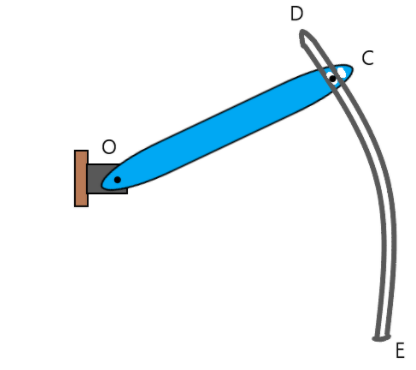Answer
64.8k+ views
Hint: radial component of the force can be gotten from the centripetal acceleration of the ball. The transverse component of the force can be derived from the tangential acceleration of the ball.
Formula used: In this solution we will be using the following formulae;
\[{a_c} = {\dot \theta ^2}R\] where \[{a_c}\] is the centripetal acceleration of a body circulating about a point, \[\dot \theta \] is the angular velocity of the body, and \[R\] is the radius of the circular path.
\[{a_t} = \ddot \theta R\] where \[{a_t}\] is the tangential or transverse acceleration of a circulating body, and \[\ddot \theta \] is the angular acceleration of the body.
\[F = ma\] where \[F\] is force exerted on a body, \[m\] is mass, and \[a\] acceleration of a body
Complete Step-by-Step solution:
To find the centripetal force, we shall first calculate the centripetal acceleration of the ball, at the given instant.
The centripetal acceleration can be given by
\[{a_c} = {\dot \theta ^2}R\] where \[\dot \theta \] is the angular velocity and \[R\] is the radius of the circle
Hence, by inserting known values, we have
\[{a_c} = {6^2}\left( {1.2} \right)\] (since 120 cm is \[1.2m\])
\[ \Rightarrow {a_c} = 43.2m/{s^2}\]
Hence, from newton’s second law, the centripetal force can be given as
\[F = m{a_c}\]where\[m\] is the mass of the body, hence for our ball, we have
\[F = \left( {2 \times 43.2} \right) = 86.4N\]
For the transverse force, we calculate the tangential acceleration which can be given by
\[{a_t} = \ddot \theta R\]where\[\ddot \theta \] is the angular acceleration of the body.
Inserting values from question, we have
\[{a_t} = \left( {66} \right)1.2 = 79.2m/{s^2}\]
Then the transverse force on the ball will be
\[F = m{a_t} = 2 \times 79.2\]
\[ \Rightarrow F = 158.4N\]
For part b)
The force exerted by the arm OC is transverse, and the force by DE is radial.
Note: for clarity, the force exerted by the arm OC is transverse because this is the part which hits the ball in linear motion, while the arm DE prevents it from going in linear motion but keeping around a circular path in the shape of itself.
Formula used: In this solution we will be using the following formulae;
\[{a_c} = {\dot \theta ^2}R\] where \[{a_c}\] is the centripetal acceleration of a body circulating about a point, \[\dot \theta \] is the angular velocity of the body, and \[R\] is the radius of the circular path.
\[{a_t} = \ddot \theta R\] where \[{a_t}\] is the tangential or transverse acceleration of a circulating body, and \[\ddot \theta \] is the angular acceleration of the body.
\[F = ma\] where \[F\] is force exerted on a body, \[m\] is mass, and \[a\] acceleration of a body
Complete Step-by-Step solution:
To find the centripetal force, we shall first calculate the centripetal acceleration of the ball, at the given instant.
The centripetal acceleration can be given by
\[{a_c} = {\dot \theta ^2}R\] where \[\dot \theta \] is the angular velocity and \[R\] is the radius of the circle
Hence, by inserting known values, we have
\[{a_c} = {6^2}\left( {1.2} \right)\] (since 120 cm is \[1.2m\])
\[ \Rightarrow {a_c} = 43.2m/{s^2}\]
Hence, from newton’s second law, the centripetal force can be given as
\[F = m{a_c}\]where\[m\] is the mass of the body, hence for our ball, we have
\[F = \left( {2 \times 43.2} \right) = 86.4N\]
For the transverse force, we calculate the tangential acceleration which can be given by
\[{a_t} = \ddot \theta R\]where\[\ddot \theta \] is the angular acceleration of the body.
Inserting values from question, we have
\[{a_t} = \left( {66} \right)1.2 = 79.2m/{s^2}\]
Then the transverse force on the ball will be
\[F = m{a_t} = 2 \times 79.2\]
\[ \Rightarrow F = 158.4N\]
For part b)
The force exerted by the arm OC is transverse, and the force by DE is radial.
Note: for clarity, the force exerted by the arm OC is transverse because this is the part which hits the ball in linear motion, while the arm DE prevents it from going in linear motion but keeping around a circular path in the shape of itself.
Recently Updated Pages
Write a composition in approximately 450 500 words class 10 english JEE_Main

Arrange the sentences P Q R between S1 and S5 such class 10 english JEE_Main

What is the common property of the oxides CONO and class 10 chemistry JEE_Main

What happens when dilute hydrochloric acid is added class 10 chemistry JEE_Main

If four points A63B 35C4 2 and Dx3x are given in such class 10 maths JEE_Main

The area of square inscribed in a circle of diameter class 10 maths JEE_Main

Other Pages
Excluding stoppages the speed of a bus is 54 kmph and class 11 maths JEE_Main

In the ground state an element has 13 electrons in class 11 chemistry JEE_Main

Electric field due to uniformly charged sphere class 12 physics JEE_Main

A boat takes 2 hours to go 8 km and come back to a class 11 physics JEE_Main

According to classical free electron theory A There class 11 physics JEE_Main

Differentiate between homogeneous and heterogeneous class 12 chemistry JEE_Main




